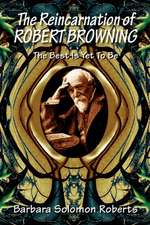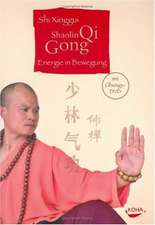Shaolin Qi Gong: Energy in Motion
Autor Shi Xingguien Limba Engleză Paperback – 18 noi 2008
Preț: 142.03 lei
Nou
Puncte Express: 213
Preț estimativ în valută:
27.18€ • 28.43$ • 22.58£
27.18€ • 28.43$ • 22.58£
Carte disponibilă
Livrare economică 12-26 martie
Preluare comenzi: 021 569.72.76
Specificații
ISBN-13: 9781594772641
ISBN-10: 1594772649
Pagini: 160
Ilustrații: 82 color illustrations
Dimensiuni: 152 x 229 x 28 mm
Greutate: 0.31 kg
Ediția:PAP/DVD
Editura: Inner Traditions/Bear & Company
Colecția Destiny Books
ISBN-10: 1594772649
Pagini: 160
Ilustrații: 82 color illustrations
Dimensiuni: 152 x 229 x 28 mm
Greutate: 0.31 kg
Ediția:PAP/DVD
Editura: Inner Traditions/Bear & Company
Colecția Destiny Books
Notă biografică
Shi Xinggui became a student at the Shaolin Monastery at the age of eight. His teachers there included Masters Shi De Shin, Shi Xu Xi, Shi De Su, and Shi De Duzan. In 1988 the author won the National Championship title for kung fu (70 kg class) in Shaolin and again in 1993 and 1994 in Zheng Zou. He received his Shaolin diploma in 1989 from Master Shi De Yuan. He now lives and teaches in Goldegg, Austria.
Extras
FROM PART 1
The Eternal Lightness of Being The Essence of Qi Gong
The concept “Qi Gong” (pronounced Chi Gung) is expressed by two Chinese characters:
Qi = life energy
Gong = work
Qi Gong therefore logically means work with life energy, which is known as Qi in China, Prana in India, Odem in some areas of the West, and often simply “energy” in modern language.
According to the Chinese conception, there is a cosmic intelligence living in the Qi. It lives in all things that exist naturally--humans, animals, plants, and minerals. Only its form of vibration changes depending on the form of manifestation.
According to the Chinese masters, every person is therefore born with a certain potential for life energy, with a certain initial capital of Qi. Everyday stress, unhealthy lifestyles, injuries, and major operations exhaust the human life energy capital to the extreme. Qi Gong is a simple technique for regaining the lost energy, reversing the deficit, and making normal life possible again.
Shi Xinggui Qi Gong
A few years ago, a physician who was taking Shi Xinggui’s course asked him how he might imagine an “internal morning shower” as a complement to external morning bathing. Shi Xinggui answered with the following combination of movements and intensive abdominal breathing.
This series of exercises is a good morning program for waking up in body and spirit and going into your day well prepared. It can also be done at other times of the day. But because of its energy potential, it should not be done right before going to bed, or it will certainly be two to three hours before you can sleep.
In Qi Gong, only a minimum of muscular force is used. But in these exercises, it is very important to work with spiritual force. This spiritual force is called Yi in Chinese. Yi means not thinking of oneself; it might be better expressed as awareness, as an intuitive understanding. It means turning all your attention to the doing, and practicing the exercises with intuitive attentiveness.
The more consciously we go through the exercises with our focus and attentiveness, the more quickly and effectively our energy reserves will be filled.
At first, go through each exercise 2 or 3 times. Once you have become more familiar with the breathing technique, you can do it more often.
Breathing Energy
This is one of the oldest Chinese breathing techniques to be mentioned in writing. Its original name is Tûná or Tugú náxîn, which could be literally translated as “giving up the old and taking in the new.”
- From the starting position, bend your knees down a bit more and form an imaginary energy ball in front of your body with both hands, about 20-30 centimeters in diameter. Between the two energy surfaces of your palms, an energetic contact emerges.
- Breathe in calmly and slowly, bringing this energy ball slowly up in front of your body to the neck area. You can also imagine that you are gently drawing energy upward from below. In doing this, stand up straight again. (Your knees remain loose.)
- Turn the palms of your hands down toward the earth. The energy is still there in your palms.
- Breathe out calmly and slowly, gently pressing the energy down with the palms of your hands. In doing this, bend your knees again, a bit more deeply. The fresh energy flows into your reservoir, your Dantian, and the used energy automatically flows out through your feet. Then repeat this succession of movements.
In order to be better able to take in energy, you can curl your toes a bit each time you breathe in, then spread them again as you breathe out. This curling makes a dimple appear in the front third of the sole (this is the location of the acupuncture point Kidney 1). Used energy is let out through this point, and fresh energy taken in. This movement is also good for the energy flow of the legs.
Note: Be especially attentive when breathing out, so that the energy can really sink downward. If you become lightheaded, immediately turn your attention to your feet, root yourself deeply in the earth, and breathe in. You will feel better right away.
Effect:
Your lungs are filled with fresh Qi, which can spread from there throughout the whole body.
Connecting
- Continue standing with your legs shoulder width apart. Check again to make sure all your joints are supple and relaxed, your pelvis slightly forward, and your tongue touching your palate. Tense your pelvic floor muscles a bit.
- Breathe in and go into a light crouch. As in the previous exercise, form an energy ball with your hands. Again, lift up the energy and your hands level with the base of your neck in front of your body, straightening up.
- Breathe out while bringing your hands around to the back of your neck, without moving the rest of your body, until your hands touch the “great vertebra point” (Chinese: Daz Hui). This is at the often prominent vertebra that marks the transition between the neck vertebrae and the thoracic vertebrae. Without interrupting the movement, bring up your hands, behind your head, until they are above your head.
- Make brief contact with the energy point at the top of your head, “heaven’s gate” or Bai Hui.
- Now your hands, above your head, grasp a ball of heavenly energy. Bend your knees slightly and breathe in.
- Now, as you breathe out, bring down this energy slowly in front of your body. Your palms face the floor and your legs slowly straighten up again.
Effect:
In order to boost the energy cycle, it is important to create a connection between the “great vertebra point” (Daz Hui) and the base of the skull. This supports the energy flow to “heaven’s gate” (Bai Hui).
The Eternal Lightness of Being The Essence of Qi Gong
The concept “Qi Gong” (pronounced Chi Gung) is expressed by two Chinese characters:
Qi = life energy
Gong = work
Qi Gong therefore logically means work with life energy, which is known as Qi in China, Prana in India, Odem in some areas of the West, and often simply “energy” in modern language.
According to the Chinese conception, there is a cosmic intelligence living in the Qi. It lives in all things that exist naturally--humans, animals, plants, and minerals. Only its form of vibration changes depending on the form of manifestation.
According to the Chinese masters, every person is therefore born with a certain potential for life energy, with a certain initial capital of Qi. Everyday stress, unhealthy lifestyles, injuries, and major operations exhaust the human life energy capital to the extreme. Qi Gong is a simple technique for regaining the lost energy, reversing the deficit, and making normal life possible again.
Shi Xinggui Qi Gong
A few years ago, a physician who was taking Shi Xinggui’s course asked him how he might imagine an “internal morning shower” as a complement to external morning bathing. Shi Xinggui answered with the following combination of movements and intensive abdominal breathing.
This series of exercises is a good morning program for waking up in body and spirit and going into your day well prepared. It can also be done at other times of the day. But because of its energy potential, it should not be done right before going to bed, or it will certainly be two to three hours before you can sleep.
In Qi Gong, only a minimum of muscular force is used. But in these exercises, it is very important to work with spiritual force. This spiritual force is called Yi in Chinese. Yi means not thinking of oneself; it might be better expressed as awareness, as an intuitive understanding. It means turning all your attention to the doing, and practicing the exercises with intuitive attentiveness.
The more consciously we go through the exercises with our focus and attentiveness, the more quickly and effectively our energy reserves will be filled.
At first, go through each exercise 2 or 3 times. Once you have become more familiar with the breathing technique, you can do it more often.
Breathing Energy
This is one of the oldest Chinese breathing techniques to be mentioned in writing. Its original name is Tûná or Tugú náxîn, which could be literally translated as “giving up the old and taking in the new.”
- From the starting position, bend your knees down a bit more and form an imaginary energy ball in front of your body with both hands, about 20-30 centimeters in diameter. Between the two energy surfaces of your palms, an energetic contact emerges.
- Breathe in calmly and slowly, bringing this energy ball slowly up in front of your body to the neck area. You can also imagine that you are gently drawing energy upward from below. In doing this, stand up straight again. (Your knees remain loose.)
- Turn the palms of your hands down toward the earth. The energy is still there in your palms.
- Breathe out calmly and slowly, gently pressing the energy down with the palms of your hands. In doing this, bend your knees again, a bit more deeply. The fresh energy flows into your reservoir, your Dantian, and the used energy automatically flows out through your feet. Then repeat this succession of movements.
In order to be better able to take in energy, you can curl your toes a bit each time you breathe in, then spread them again as you breathe out. This curling makes a dimple appear in the front third of the sole (this is the location of the acupuncture point Kidney 1). Used energy is let out through this point, and fresh energy taken in. This movement is also good for the energy flow of the legs.
Note: Be especially attentive when breathing out, so that the energy can really sink downward. If you become lightheaded, immediately turn your attention to your feet, root yourself deeply in the earth, and breathe in. You will feel better right away.
Effect:
Your lungs are filled with fresh Qi, which can spread from there throughout the whole body.
Connecting
- Continue standing with your legs shoulder width apart. Check again to make sure all your joints are supple and relaxed, your pelvis slightly forward, and your tongue touching your palate. Tense your pelvic floor muscles a bit.
- Breathe in and go into a light crouch. As in the previous exercise, form an energy ball with your hands. Again, lift up the energy and your hands level with the base of your neck in front of your body, straightening up.
- Breathe out while bringing your hands around to the back of your neck, without moving the rest of your body, until your hands touch the “great vertebra point” (Chinese: Daz Hui). This is at the often prominent vertebra that marks the transition between the neck vertebrae and the thoracic vertebrae. Without interrupting the movement, bring up your hands, behind your head, until they are above your head.
- Make brief contact with the energy point at the top of your head, “heaven’s gate” or Bai Hui.
- Now your hands, above your head, grasp a ball of heavenly energy. Bend your knees slightly and breathe in.
- Now, as you breathe out, bring down this energy slowly in front of your body. Your palms face the floor and your legs slowly straighten up again.
Effect:
In order to boost the energy cycle, it is important to create a connection between the “great vertebra point” (Daz Hui) and the base of the skull. This supports the energy flow to “heaven’s gate” (Bai Hui).
Cuprins
Introduction: My Journey to Shaolin
Part 1. What Is Shaolin Qi Gong?
The Eternal Lightness of Being: The Essence of Qi Gong
Heaven, Earth, and Human
The Fundamentals of Shaolin Qi Gong
The Beginnings
Qi Gong for Maintenance of Health
Yin and Yang
The Three Dantians
Part 2. The Exercises
The Discovery of Slowness
Preparatory Exercises: Opening and Awakening the Body
Starting Position
Hand-rubbing
Energizing the Temples
Washing the Face
Tapping the Head
Stimulating the Central Body by Tapping
Tapping the Legs and Arms
Raising Heaven
Stroking Earth
Attentiveness for Developing Qi
Concentration
Breathing
Shi Xinggui Qi Gong
Joining Heaven and Earth
Turning Wheels
Shaolin Power Exercises
Breathing Energy
Opening
Connecting
Letting Go
Closing
Shi Xinggui Qi Gong in Short Form
Everyday Exercises
Heart Centering and Organ Strengthening
Diagonal Stretching
Warming the Center
Energy Balancing and Standing Meditation
Evening Exercises
The Energy Reserves: Closing for All Exercises
Appendix: Shi Xinggui Qi Gong Exercise Sequences
About the Author
About Eleanore Vogl
About the Music on the DVD
Recenzii
“The book alone will be enough for most beginners to learn the basic moves and begin practicing them right away. A marvelous bonus, however, is the DVD that accompanies the text. . . . The music, based on the pentatonic scale, is particularly soothing, adding to the sense that there is no rush, no right or wrong, and no need to fret about perfection while practicing qi gong. . . . I've tried other books and DVD courses, in the past, but none of them has given me the natural flow of qi gong. . .”
"The scenery and the music on the DVD are very serene and beautiful in a way that was supportive to the exercises and following along, without intruding upon them. Anyone looking for a book on the absolute basics of Qi Gong and how to perform different exercises would not go wrong with picking up this book and DVD. I heartily recommend them."
"This excellent guide teaches some of the basic forms of qigong, a traditional technique of Chinese energy movement that promotes energy and well-being. . . . A 45-minute DVD of selected exercises by Shi Xinggui is included, making this an effective tool for self-instruction."
"This seems to be just as much about inner peace as it is physical exercise. I have gained a new respect for the topic after watching the video. . . . If you are looking for a VERY low-impact exercise system that will, at the very least, improve your flexibility and peace of mind, pick this up and follow along."
"Throughout the text one becomes aware of this kind, gentle, but relentless dedication to taking the reader, trainee or initiate, to new and higher levels of achievement. At no point is there any sense of the beginner's limitations, only a sense of promise ahead and the value inherent in working towards clear goals. . . . while being a book artfully designed to meet the needs of a contemporary, pressured, and chaotic experience, Shaolin Qi Gong: Energy in Motion is also a book that is likely to introduce many to the wisdom of Buddhist spirituality and to the disciplines of perhaps today's most fabled form of martial arts."
"The scenery and the music on the DVD are very serene and beautiful in a way that was supportive to the exercises and following along, without intruding upon them. Anyone looking for a book on the absolute basics of Qi Gong and how to perform different exercises would not go wrong with picking up this book and DVD. I heartily recommend them."
"This excellent guide teaches some of the basic forms of qigong, a traditional technique of Chinese energy movement that promotes energy and well-being. . . . A 45-minute DVD of selected exercises by Shi Xinggui is included, making this an effective tool for self-instruction."
"This seems to be just as much about inner peace as it is physical exercise. I have gained a new respect for the topic after watching the video. . . . If you are looking for a VERY low-impact exercise system that will, at the very least, improve your flexibility and peace of mind, pick this up and follow along."
"Throughout the text one becomes aware of this kind, gentle, but relentless dedication to taking the reader, trainee or initiate, to new and higher levels of achievement. At no point is there any sense of the beginner's limitations, only a sense of promise ahead and the value inherent in working towards clear goals. . . . while being a book artfully designed to meet the needs of a contemporary, pressured, and chaotic experience, Shaolin Qi Gong: Energy in Motion is also a book that is likely to introduce many to the wisdom of Buddhist spirituality and to the disciplines of perhaps today's most fabled form of martial arts."
Descriere
Authentic qi gong as practiced in the Shaolin Temple where this discipline originated centuries ago.















